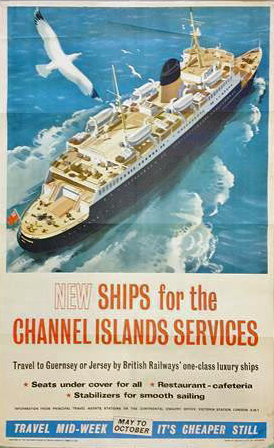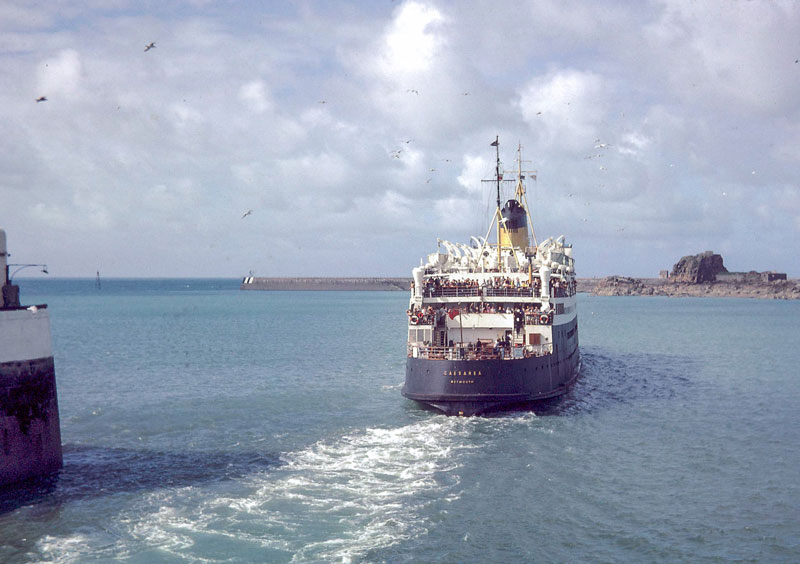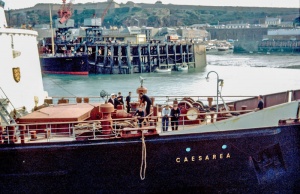Isle of Sark
The ship which left the Channel Islands run was the Isle of Sark. As she left the Island for the last time, her master, Capt F Cantle, ordered flags signalling ‘Goodbye’ to be flown from her masts. And as she rounded Corbière, he and her crew had the pleasure of seeing the same signal flown from the lighthouse – with the addition of flags which conveyed the message ‘Well done’.
The Isle of Sark was hardly luxurious, but she was fitted with stabilisers for the safety and comfort of passengers. When her successor, the Caesarea, arrived on her maiden voyage on 18 November 1960, stabilisers were just one among many devices, facilities and furnishings designed with passenger comfort in mind.
State of the art
Anyone who still has memories of making the long and all too often storm-tossed crossing to Weymouth in the Caesarea – or her sister ship, the Sarnia – might question the idea that these vessels were in any way luxurious or comfortable. However, when the new mailboat entered service she was regarded as a state of the art ferry for cross-Channel operations.
Built in Cowes on the Isle of Wight, the Caesarea was launched by Lady Coutanche, the wife of the Bailiff of the day, Sir Alexander Coutanche, in January 1960. She was then fitted out for some months before being ready for her first voyage. Her name was the word that the Romans are supposed to have used for Jersey, though there is no real evidence to support this long-held belief.
The new ship was destined to be one of the principal links between the islands and the UK port of Weymouth. British Railways, then the operator on this ferry route, must also have had an idea of how warm a welcome their latest vessel would receive in the Islands. In the event, a large crowd, which included the Bailiff and Lady Coutanche, gathered at St Helier Harbour to see the Caesarea berth alongside the Albert Pier.
Over the course of the few days that she remained in the Island, 18,000 people – a third of the population – took the opportunity to go on board to see for themselves what was now on offer for cross-Channel passengers.
On her arrival, other ships in port greeted the newcomer with blasts on their sirens and the States tug, the Duke of Normandy, which was not needed as the Caesarea’s master, Capt V Newton, eased her into harbour, was dressed overall with flags and pennants.
1,400 passengers
Although she was designed to carry 1,400 passengers, the only people on board for the maiden voyage besides the crew, which would number 78 in full service, were British Railways officials and Sir James Milne, the managing director of Samuel White and Co Ltd, the ship’s builders, and Lady Milne.
At 4,174 tons displacement, the Caesarea represented a step up from other vessels on the Channel Islands run. She was 322 feet long, 51 feet in the beam, drew 13 feet 6 in, had five decks and a single funnel designed to take smoke away from passengers on the open decks in all weather conditions.
She was powered by two steam turbines driving two three-blade propellers and had a bow rudder to help her manoeuvre when going astern in tight spaces such as St Helier Harbour.
With 11 watertight bulkheads and a double-bottom hull, which had been tested in prototype at the National Physical Laboratory, she was also designed to be a safe vessel, though if the unthinkable ever happened she was equipped with six GRP lifeboats and 45 inflatable rafts.
On board there was only one class of passenger accommodation, which had seating for everyone who could be carried. In addition, there were 64 private cabins, a restaurant, a cafeteria and a bar which served duty-free drinks when the ship was on the high seas. In terms of décor, the Caesarea was an interesting mixture of ancient and modern, use having been made of teak finishes and the latest plastics.
After the ship entered regular service in December 1960, she became one of the major lifelines linking the Channel Islands with the south coast of the UK, sailing come rain or shine and in all but the most severe sea conditions. Countless visitors and Islanders used her as a reliable means of getting to and from the islands until her last CI voyage in April 1978, though she ceased to be a regular vessel on the service in October 1975.
Brochure describing new ships
Comfort is the keynote
The 'Caesarea' and her sister ship 'Sarnia' were custom built to carry up to 1,400 holidaymakers and their luggage in the greatest possible comfort and with the utmost reliability.
The ships are not only the largest which can be handled in St. Helier harbour but are the biggest ever to be constructed for the Channel Islands service.
Since their introduction they have proved to be immensely popular — a fact borne out by the tremendous increase in the numbers who choose to travel by sea. And the reasons for this are not hard to find. For there is no more pleasant a way of starting a holiday than with a cruise — it's easy to make friends with fellow holiday-makers in the relaxed, elegant atmosphere of the ship — everyone is assured of a comfortable seat — the chances of being stranded in the Islands by mist or fog are practically non-existent — and the fares are most reasonable.
All this adds up to the fact that these ships provide a first-class 'one-class' service.
Railway improvements
The electrification of the line from London to Bournemouth has cut the journey time to Weymouth. Holidaymakers can travel up from a wider area of the Home Counties to catch the train, at Waterloo. The electric expresses cover the 143 miles to Weymouth in about 3 hours and set a new high standard of comfort.
A new customs baggage hall built at Weymouth Quay has speeded up the transfer from ship to shore and the new facilities include a ticket office, waiting hall and offices for the motoring organisations.
A free service of special containers is provided on the quayside at Weymouth, Guernsey and Jersey in which you can place your luggage. You can then forget all about it until you collect it again on the quayside at your destination port.
It is now no longer necessary to wait until early January to make your booking for the peak holiday months. You can make advance bookings at any time, although sailing tickets will be required on some dates.
Passenger accommodation
Passengers are carried on all decks except the navigating bridge. The private cabins and sleeping lounges are situated on the lower deck, the two de-luxe cabins on the promenade deck. The public rooms are arranged on the main, upper and promenade decks.
Private cabins. Colourful furnishings and modern decor are a feature of the 25 double and 12 single cabins. Pleasantly proportioned, they are well appointed, have washbasins and interior sprung mattresses, and provide a high degree of comfort. Two luxury suites are double berth cabins with private bathrooms, complete with built-in showers.
The Public Rooms. The Smoke Room and Bar at the forward end of the promenade deck is attractively panelled in Andaman Padauk and East Indian Rosewood. Armchairs and fixed seats subdivided by upholstered armrests, provide seating for 95 passengers. Tables are in rosewood with plastic tops coloured to match the seats. The long curved bar is faced with white plastic.
Delightful lounges on the upper and promenade decks, have seats in restful colours enabling a total of 520 passengers to relax in comfort. The panelling of the lounges is carried out in Lebanon Cedar and Andaman Padauk.
The buffet and bar at the aft end of the promenade deck is panelled in teak and yew, as is the centrally situated buffet on the upper deck.
Excellent meals are served in the spacious restaurant, which accommodates 110 passengers at one sitting. Richly panelled in English yew throughout, the inner and outer rows of chairs are alternately coloured in pleasing shades of red and blue-green.
On the main deck amidships there are 118 adjustable reclining seats, and aft of these a spacious lounge with chairs for 142 passengers. A shop is also provided on this deck.
In addition to the enclosed seating in lounges, seating is provided for over 400 passengers in sheltered positions on the open decks.
For the technically minded
The ships have a raked stem, rounded stern, two tripod masts and a single funnel which has been designed to obviate the nuisance caused by fumes being blown down to the boat deck under adverse wind and weather conditions.
There are two continuous decks, main and upper, with a promenade deck, navigating bridge deck and a flying bridge. A lower deck is arranged forward and aft of the machinery spaces.
Two sets of the latest Pametrada designed steam turbines with a total output of 8,500 SHP drive, through locked train, articulated, double reduction gearing two three-bladed 10 foot diameter propellers. Two oilfired watertube boilers, fitted with superheaters, supply steam at a working pressure of 350 psi and temperature of 650 F to the main turbines and auxiliary machinery.
The oil burning equipment works at a maximum pressure of 500 psi.
Each ship has a stern and bow rudder, the latter being fitted to enable the vessel to navigate stern first at speed when entering port. The rudders are power operated — electro-hydraulic turning vane type steering gears are capable of moving the rudder from hard over to hard over in not more than 18 seconds.
A Denny-Brown stabiliser is fitted in each vessel to minimise rolling in heavy seas. This equipment consists essentially of two fins, one each side amidships, normally housed inside the line of the hull, but which can be extended by hydraulic power at sea. Any rolling of the ship acts on a gyroscope, which in turn, through electrical and hydraulic relays, instantly tilts the fins to counteract the roll.
Three 225 kW 225 volt DC diesel driven generators supply electricity for lighting and power. A 50 kW 225 volt DC diesel engined generator is provided for emergency duties. The standard of electric lighting on these ships is particularly high.
The latest types of navigational equipment are provided to assist the Master in every way possible to combat fog and other hazards.
Special provision has been made in the design and equipment to deal with the possible hazard of fire. The ships, in addition to being provided with sprinkler systems, have been divided into fireproof zones, each zone containing equipment to detect and fight fires.
Six fibreglass lifeboats and 47 inflatable liferafts are carried in each ship. Two of the boats are diesel engined; the remaining four are hand propelled. The latest approved type lifejackets are provided for each passenger and member of the crew.
Statistics
- Overall length: 322 feet
- Breadth; 51 feet
- Loaded draught (mean): 13ft 6in
- Gross tonnage: 4,174 tons
- Shaft horse power: 8,500
- Speed: 20 knots
- Stabiliser fins: length – 8ft 6in; width – 4ft 2in
- Maximum working angle: 20 deg
- Pressure on fins at maximum angle and at service speed: 311 tons
- Full complement: passengers - 1,400; crew - 78
Materials
- 1,300 tons of steel
- 6½ miles of steel piping
- 3¼ miles of copper and alloy piping
- 60 miles of electric cable
- Over 100 electric motors from 75 hp to fractional hp
- 1,700 electric light bulbs
- 1,400 feet of strip lighting
- 40,000 sq ft of laminated plastic
- 31,500 sq ft of linoleum
- 25,000 sq ft of Marinite fireproof bulkheads
- 20,000 sq ft of wood veneers
Timeline
To many it was the golden era of sea travel to the Channel Islands as sister ships Sarnia and Caesarea, purpose-built for the routes, operated side by side from 1960 till the late 1970s.
They were operated by British Rail from Weymouth when tourism was at at all-time high. Boat trains operated from London Waterloo and Bristol and the North, directly to the quayside at Weymouth, travelling the last mile of their journey through the streets of the town. The demise of these vessels came after only 15 years as the introduction of the car ferry made them instantly obsolete.
The history of Caesarea: [1]
- 5 November 1960: delivered
- 1960: Weymouth-Jersey-Guernsey
- 1972: Collided with the quay in St Peter Port. Repaired in Falmouth
- 1973: Stranded in Jersey, repaired
- 1975: Last day of regular service between Weymouth-Jersey-Guernsey
- 1976: Departed Weymouth for Dover
- 1976: Dover-Calais
- 1977: Dover-Boulogne
- 1978: Relief ship Weymouth-Jersey-Guernsey
- 1979: Registered for Sealink UK
- 1980: Folkestone-Calais-Boulogne
- 1980: Dover-Folkestone- Calais-Boulogne
- 1980: Laid up Newhaven.
- 1980: Sold to Superluck Enterprises, Panama. Departed Newhaven for Hong Kong
- 1981: Arrived in Hong Kong. Renamed Aesarea
- 1983: During the hurricane Ellen the ship ended up on land, but was pulled off the next day
- 1984: Sold to unknown buyers, Philippines
- 1986: Arrived at Kure, Japan for a planned hotel ship, which never happened
- 1986: Departed Kure for South Korea for scrapping
Earlier vessels
- Caesarea, the first Caesarea
- Caesarea and Sarnia, the second Caesarea and Sarnia
Click on any image below to see a full-size version
Amateur photographs
A set of photographs of Caesarea at St Helier by an unknown amateur photographer
Notes and references
- ↑ From Facebook group Maritime Jersey, by Mark Pulley































































